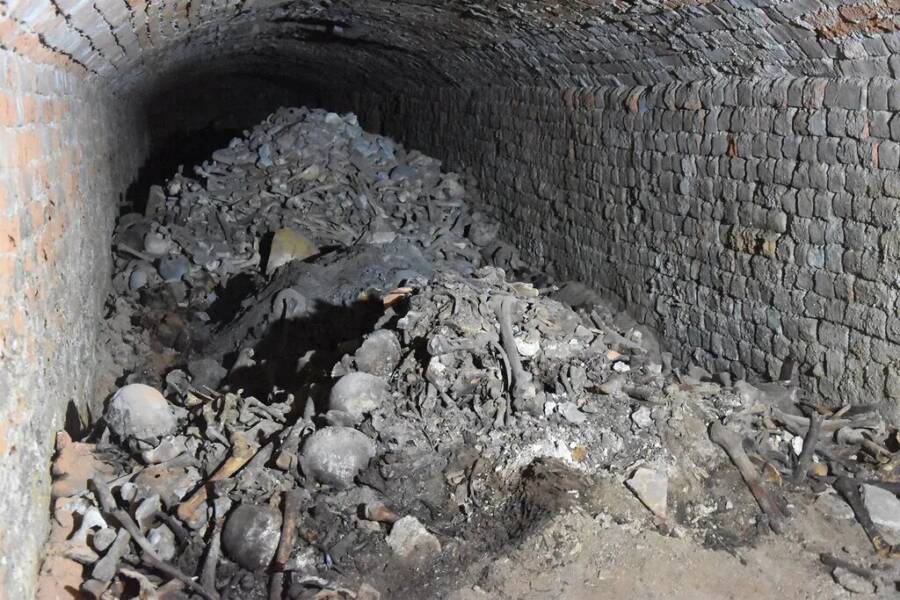Researchers examining human remains in a 17th-century crypt in Milan found evidence of cocaine use, suggesting that Europeans consumed coca leaves nearly two centuries earlier than previously thought.

Mattia M.Researchers examine human remains inside the Ca’ Granda crypt in Italy.
For years, historians have assumed that cocaine wasn’t widely used in Europe until the 19th century, after the German chemist Albert Niemann figured out how to isolate the drug from coca leaves in 1859. However, new evidence could push the timeline of European cocaine use back almost two centuries.
Researchers studying a crypt beneath the Ospedale Maggiore hospital in Milan, Italy recently discovered components of the coca plant within the mummified brains of two individuals that had been buried there in the 17th century. This discovery suggests that coca, a plant native to South America, reached Europe by the 1600s — making it the earliest known evidence of cocaine use on the European continent.
The researchers hypothesize that the coca plant was introduced to Europe by the Spanish. Records from the Ospedale Maggiore hospital make no mention of coca in treatments, suggesting the mummified individuals used the drug outside of formal medical settings — and may have even used it recreationally.
Researchers Examine Human Remains At The Historic Ca’ Granda Crypt

Mattia M.The Ca’ Granda crypt below the Ospedale Maggiore hospital.
In 2019, researchers from the University of Milan and the Foundation IRCCS Ca’ Granda Ospedale Maggiore Policlinico di Milano took on the task of studying human remains inside the Ca’ Granda crypt, a 17th-century burial site for patients who died at the Ospedale Maggiore hospital in Milan.
Today, some 2.9 million bones are spread across the crypt’s 14 chambers, offering researchers a unique opportunity to learn about life and death in Milan some 400 years ago.
When graduate student and study lead Gaia Giordano first entered the crypt as part of the research project, she was immediately overwhelmed by the amount of human remains.
“You see a floor of bone, full of bones,” Giordano told the New York Times.

Mattia M.Piles of human remains inside the crypt.
Researchers examined the mummified brains of nine individuals buried in the crypt. Using a spectrometer, they discovered that at least two of them showed signs of cocaine use, likely the result of chewing coca leaves.
Their findings, published in the Journal of Archaeological Science, revealed that Europeans used cocaine nearly 200 years earlier than previously believed.
Europeans Enjoyed Coca Centuries Earlier Than Previously Thought

Wikimedia Commons / CC BY-SA 3.0Erythroxylum novogranatense, a type of coca plant.
The study of human remains in the Ca’ Granda crypt suggests that 17th-century Europeans were consuming coca, a native South American plant used to create cocaine.
When chewed, coca leaves produce a stimulating effect and can also offer relief from pain. Andean societies have consumed the leaves for thousands of years, but it wasn’t until the Spanish arrived in the region that word of the drug spread to Europe. In the 16th century, Spanish missionary José de Acosta noted that the coca plant “works with great force and gives encouragement” to Indigenous people in South America.
Researchers hypothesize that the Spanish could have observed the coca leaves’ pain relieving properties and brought them back to Europe. At the time, Milan was a center for international trade and could have been among the first cities to receive the plant.
Surprisingly, Ospedale Maggiore hospital records made no mention of coca leaves as a treatment for patients. Researchers surmise that this suggests the coca plant was “lurking among the population,” and that the two mummified individuals consumed the leaves outside of a hospital setting.
These findings have the potential to rewrite the history of drug use in Europe, paving the way for further research into early modern European drug habits.
“I think it’s super exciting,” Benjamin Breen, a historian at the University of California, Santa Cruz, told the New York Times about Giordano’s findings. “So much of what we know about the past has been based on information from written records. But if we compare what’s in a book to physical evidence, like what’s in someone’s brain, that’s a whole new dimension.”
After reading about the earliest evidence of cocaine use in Europe, dive into the story of Pablo Escobar’s dangerous cocaine hippos that are wrecking havoc in Colombia. Then, read about how the Nazis used methamphetamines to fuel their war effort.





